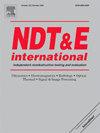Predictive probability of detection curves for ultrasonic testing
IF 4.1
2区 材料科学
Q1 MATERIALS SCIENCE, CHARACTERIZATION & TESTING
引用次数: 0
Abstract
The probability of detection (POD) is one of the most meaningful ways to quantify the detectability of damage, because it considers the statistical variability in the measurements. Predictive probability of detection (P-POD) curves are particularly efficient, as they generate POD curves based on a series of measurements from undamaged specimens, without having to run a series of destructive tests. P-POD methods are model-assisted, but instead of generating synthetic data, a sensitivity matrix is extracted from the model, and the measurement uncertainties are quantified based on experimental tests. However, so far, they have only been applied to global structural health monitoring applications. This paper sets out to apply the P-POD method to ultrasonic testing for the first time, and to experimentally validate the predictions for contact-based and air-coupled measurements. For that purpose, a contact ultrasound study is carried out, where changes of circular reflectors from their nominal values are evaluated in a polyamide cuboid based on the maximum reflected wave amplitude. Moreover, an air-coupled ultrasonic test is performed to determine thickness changes of a carbon fiber-reinforced polymer plate based on time-of-flight considerations. In both cases, the predicted POD is compared with empirical tests. The results show that the P-POD accurately predicts the POD with very small absolute deviations between predicted and actual POD. Since P-POD methods require analytical models that relate measured damage indicators to material changes, a separate study is added to demonstrate how the model-based uncertainty can be quantified using confidence intervals, and how it can be distinguished from data-driven uncertainties. As mentioned above, the POD can be predicted based on undamaged specimens, and that is why the P-POD method is an appropriate tool to optimize user-defined signal processing parameters before scanning the objects. To demonstrate this, different onset pickers are analyzed in a comparative study, where the one based on the Akaike information criterion led to a POD up to 38% higher than other pickers.
求助全文
约1分钟内获得全文
求助全文
来源期刊

Ndt & E International
工程技术-材料科学:表征与测试
CiteScore
7.20
自引率
9.50%
发文量
121
审稿时长
55 days
期刊介绍:
NDT&E international publishes peer-reviewed results of original research and development in all categories of the fields of nondestructive testing and evaluation including ultrasonics, electromagnetics, radiography, optical and thermal methods. In addition to traditional NDE topics, the emerging technology area of inspection of civil structures and materials is also emphasized. The journal publishes original papers on research and development of new inspection techniques and methods, as well as on novel and innovative applications of established methods. Papers on NDE sensors and their applications both for inspection and process control, as well as papers describing novel NDE systems for structural health monitoring and their performance in industrial settings are also considered. Other regular features include international news, new equipment and a calendar of forthcoming worldwide meetings. This journal is listed in Current Contents.
 求助内容:
求助内容: 应助结果提醒方式:
应助结果提醒方式:


